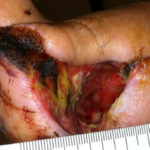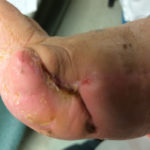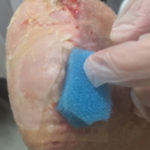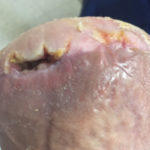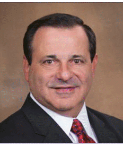
Dr. Matthew G. Garoufalis has a private practice in Chicago and is the Associate Chief of the Podiatry Section and Podiatric Medicine and Surgery Residency Director at the Jesse Brown VA Medical Center. He is a Past President of the American Podiatric Medical Association, and is also the current President of the International Federation of Podiatrists. Dr. Garoufalis is a Fellow of the Faculty of Podiatric Medicine of the Royal College of Physicians and Surgeons of Glasgow He is also a Certified Wound Specialist by the American Board of Wound Management. He has authored many articles and has accepted speaking engagements for educational lectures, seminars and workshops extensively both nationally and internationally, on a variety of topics pertinent to wound care, podiatric medicine and surgery, and practice management. He is considered a Key Opinion Leader in many areas.
Garoufalis_Current Dialogues in Wound Management_2017_Volume 3_Issue 2
NOTE: As with any case study, the results and outcomes should not be interpreted as a guarantee or warranty of similar results. Individual results may vary depending on the patient’s circumstances and condition.
Up until recently we only had electrically or battery powered devices available for use for our patients. We now have the ability to use a mechanically powered negative pressure therapy system that is ultra-portable and lightweight. The SNAP™ Therapy System weighs 0.1 kg, or about 2.2 ounces and is entirely disposable with no audible alarms and functions with continual negative pressure. The SNAP™ Therapy System is ideally suited to our Veteran’s Administration out-patient population for reasons that I articulate below. Many of our veterans are currently suffering with difficult to heal wounds. While exact percentages are difficult to estimate, in my opinion and clinical experience, frequent and multiple comorbidities suggest a higher-than-normal percentage of difficult to heal wounds as compared with a non-VA population. This device is discreet and virtually unnoticeable in social situations. Patient-reported benefits at our center in the cohort of patients we have treated, suggest that it makes minimal noise, is easy to sleep with and has less interference with daily activities.
From a clinical point of view, three different studies by Lerman et al., Armstrong et al., and Marston et al., have all demonstrated the SNAP™ Therapy System. The dressing consists of a blue foam interface that fills the wound. Other products may also be applied to the wound bed if needed. The SNAP™ SecurRing™ Hydrocolloid is fashioned around the wound edge. The sealant layer, which is a proprietary hydrocolloid dressing with an integrated tubing port, is laid down over the wound, the foam and the SNAP™ SecurRing™ Hydrocolloid, and a seal is then assured. The tubing is then connected and cut to the appropriate length so that the cartridge can be inconspicuously placed, either beneath the pants leg, on the belt, or wherever the patient desires. The tubing is also then easily secured such that it minimizes the tripping hazard that may potentially be associated with such treatment modalities. The cartridge comes primed and requires only the removal of the Activation Key to initiate NPWT. Once it has subsequently been connected to the tubing, the SNAP™ Therapy System is ready to go. Because this is an off-the-shelf product, the whole assembly takes just a matter of minutes to connect.
 Figure 1: SNAP™ Therapy System components
Figure 1: SNAP™ Therapy System components
Let’s take a look at a few cases in which our center used the SNAP™ Therapy System. Firstly, we share the case of a 54 year-old male with diabetes mellitus and peripheral vascular disease. The patient had an ulcer on the dorsum of his great toe which resulted in osteomyelitis of the hallux and the 1st metatarsal head (Figure 2). We completed a surgical resection of the 1st ray and after the “clearance”, specimens were returned free of bacteria and the SNAP™ Therapy System was applied 10 days post-surgery.
The SNAP™ Therapy System was continued for 4 weeks in conjunction with an amniotic membrane dressing. We also applied NPWT at -125 mmHg with weekly cartridge changes. After 4 weeks with the SNAP™ Therapy System, the wound was able to fill completely and 4 additional weeks of grafting resulted in complete closure (Figure 3).Our second case involves a 67 year old male who presented 3 weeks after a trans-metatarsal amputation. The patient was non-diabetic, had defined neuropathic pain with palpable pulses and a positive probe-to-bone (PTB) test (Figure 4).
After one week of SNAP™ Therapy System application, we debrided the wound and placed an amniotic mesh graft under the SNAP™ Therapy System’s blue foam (Figures 5A and 5B). The graft and foam were sized to the wound, the hydrocolloid ring was fashioned for quick sealing to the wound surface, the SNAP™ Advanced Dressing was applied and NPWT was commenced.
At 2 weeks post SNAP™ Therapy System application, we noticed a 30% decrease in wound volume and at the 3 week mark, an even more significant reduction in volume of 92% with complete wound closure at Week 4 (Figure 6). Our center’s experience with the SNAP™ Therapy System has been a positive one in my opinion given the patient population that we serve where comorbidities and wound complexity may be higher than that observed in a non-veteran population.
References
1.Armstrong DG, et al. Comparative effectiveness of mechanically and electrically powered negative pressure wound therapy devices: A multicenter randomized controlled trial. Wound Repair and Regeneration. 2012 May;20(3):332-41.
2.Lerman B, et al. Evaluation of chronic wound treatment with the SNAP™ Therapy System wound care system versus modern dressing protocols. Plastic and Reconstructive Surgery. 2010 Oct;126(4):1253-61.
3.Marston WA, et al. A multicenter randomized controlled trial comparing treatment of venous leg ulcers using mechanically versus electrically powered negative pressure wound therapy. Advances in Wound Care. 2015 Feb;4(2):75-82.

